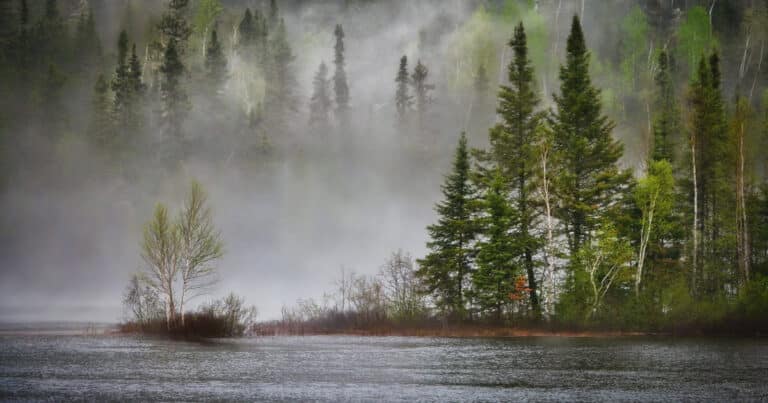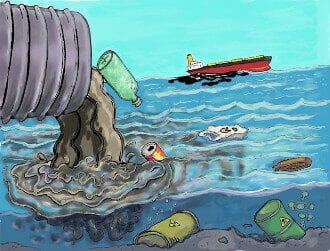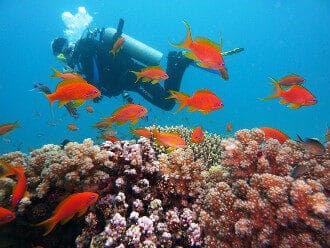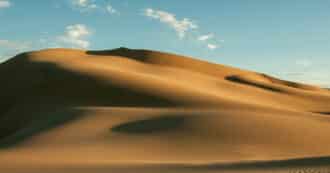By Rachel Cohen – An ecosystem is a combination of all living things (biotic) and nonliving things (abiotic) in a confined area. Across the world, there are three major different types of ecosystems, freshwater, ocean or aquatic ecosystems, and terrestrial ecosystems.
The Composition Of An Ecosystem
Though there are many different types of ecosystems there are some common factors between all of them. This includes the biotic and abiotic components, a food chain and a variety of energy flows.
Energy flows take place between the food chain and the biotic and abiotic factors. For instance, the sun (abiotic) supports photosynthesis for plants (biotic), which is then eaten by an animal, and that animal is then sustained.
There are various levels of biotic components: producers, consumers, and decomposers. A producer is a plant that uses energy from the sun to produce glucose which will feed the food chain later on. A consumer then eats the producer. For example, a rabbit eating grass. Once the consumer dies, decomposers such as fungi will break down the consumer’s body which will be absorbed back into the ground.
Humans Are Part of The Ecosystems
Each of these ecosystems acts as a home for millions of animals and plants, and even more for humans. Humans can take food, shelter, and resources from all of these ecosystems. Though there seems to be a beneficial relationship, our constant taking of resources is actually hurting the ecosystems.
Some of the biggest threats facing our ecosystems include deforestation, coral bleaching, overfishing, climate change, and pollution, which have all been caused by humans. Each type of ecosystem is naturally balanced and human disruption is causing an imbalance.
Freshwater Ecosystems
Freshwater is water that is naturally produced by the earth and contains very little salt. With this stringent requirement, it becomes very difficult to find fresh water. Only about 3% of the world’s water is freshwater, and even less than that is in liquid form as most of it is frozen in glaciers or found in underground aquifers.
Though there is a limit to how much freshwater we have for drinking, showering, or washing hundreds of millions of animals call freshwater areas their homes. Some of these animals include fish, frogs, turtles, alligators, and many types of insects. These animals live in harmony and have a natural balance that is being greatly disturbed by humans.
Freshwater ecosystems host different animal species than saltwater. This is due to the biological differences between the animals. Animals that live in salt water have a high concentration of salt solution that keeps water out of their cells. If they were to go into freshwater, their bodies would absorb all the water eventually killing them.
In contrast, freshwater animals in salt water would become dehydrated. The salt concentration would pull the water out of their bodies leading to their deaths.
Threats to Freshwater Ecosystems
As with all aspects of the earth, humans are causing irreversible damage, especially to freshwater ecosystems. Whether it is through pollution, building hydraulic dams, farming or rising global temperatures there are huge threats to freshwater ecosystems.
Pollution As A Threat To A Freshwater Ecosystem
One of the first threats facing this ecosystem is the threat of pollution. Pollution comes in many different forms. It can be seen in the accumulation of trash in freshwater, or even as toxic chemicals being dumped into the ecosystem. Trash accumulation can harm animals in the area if they mistake it for food.
A very common scenario is an aquatic animal eating a piece of plastic that they ultimately choke on. Though one small action may not seem to matter, each one begins to add up and causes great harm to the animals of the ecosystem.
The dumping of toxic chemicals creates unsafe habitats for the animals, again resulting in a deadly chain reaction. It can even harm humans as some may have to rely on an area of fresh water for drinking or showering which they can no longer do.
Not only can toxic chemicals cause harmful situations, but the build-up of nutrients can also greatly impact aquatic ecosystems. In this blog post from ICSD’s blog, Sydney Cohen explains the harmful process of eutrophication which is also causing harm to the ecosystem.
Hydraulic Alterations Are A Threat To A Freshwater Ecosystem
A second threat facing freshwater is hydraulic alterations. These alterations can include activities such as farming and the creation of dams. Anytime that the natural flow of water is disturbed, the natural balance will be altered.
Issues that can arise from this include a lack of resources for those who use the water and the possibility of water downstream disappearing. For example, fish farming can hoard massive amounts of fish from downstream.
Animals who may rely on the stream for those fish will have to drastically change their diets and can face major complications. Building dams can cause similar issues. The blocking of water will reduce how much water downstream will be available for those who need it. This affects both animals’ and humans’ way of life.
Rising Temperatures Are A Threat to A Freshwater Ecosystem
Rising temperatures cause issues for the entire world and freshwater ecosystems. When the air temperatures rise, it also increases the temperatures of the water. As the water warms it becomes uninhabitable for many fish.
The Oceanic Ecosystem
Just like freshwater ecosystems, ocean or marine ecosystems are filled with millions of animal species that call the ecosystem home. Marine ecosystems include the ocean as well as estuaries, salt marshes, mangrove forests, coral reefs, the open ocean, and the deep-sea ocean. Each of these areas hosts different types of animals that create a natural balance in nature.
Each mini-ecosystem offers protection, food, and resources for animals. Animals range from massive in size, like whales and sharks, to tiny bacteria that live at the bottom of the ocean where there is no light.
Threats to Coral Reef Ecosystems
The ocean covers 70% of the earth’s surface which lends itself to hundreds of threats. However, one of the areas that is regularly threatened is the coral reef ecosystem.
Coral reefs act as homes and protection for millions of animals, yet humans are destroying the area. These threats include rising ocean temperatures leading to ocean acidification and coral bleaching. Chemicals can lead to algae growth which harms the coral reefs and creates a harsh environment for other organisms.
Other threats include physical damage from people. Some people may feel it is okay to take small bits of coral as souvenirs, but each small action adds up and causes great harm to the reefs.
Terrestrial Ecosystems
A terrestrial ecosystem encompasses a wide variety of ecosystems, including the grassland ecosystem, forest ecosystem, temperate forest ecosystems, desert ecosystem, temperate deciduous forests, tropical rainforests, and tundra ecosystems.
Just like the other ecosystems terrestrial ecosystems offer resources for animals and humans, homes for many animal species, and food options. These relationships are important to the balance of the natural world.
Each of the previously mentioned terrestrial ecosystem hosts different species that have created a natural balance. A grassland ecosystem hosts animals in warm climates such as lions or giraffes, while tropical rainforests host millions of species of birds, frogs, snakes, and other organisms.
Threats To Terrestrial Ecosystems
One of the largest terrestrial ecosystems is the rainforest which is facing threats every day. Some of these threats include logging, unsustainable cattle ranching, slash and burn practices, mining, and destruction of trees for roads.
Logging can be unsustainable if no trees are being planted in replacement. For instance, in the last 50 years, 17% of the Amazon Rainforest has been destroyed. By not planting trees for each one cut down, we run the risk of destroying the entire ecosystem.
These unsustainable habits place stress on the biotic and abiotic components of the ecosystem. Animals lose homes, plants disappear and the possibility of invasive species arises. The disturbance of the natural world by human practices put the balanced ecosystem at a risk.
Actions To Care for Ecosystems
It can seem overwhelming to think about what can be done to save the earth. However, there are a lot of small choices you can make that can make a difference. Every action you take can add up and create a difference.
When it comes to our aquatic ecosystems, one of the best choices you can make is to be mindful of your trash. Keeping your trash out of the water will help save the lives of aquatic animals.
Another choice you can make, especially in the warm months, is to be mindful of your sunscreen choices. Sunscreen that is filled with chemicals will wash off your body and can be harmful to animals in the ocean.
A third choice you can make is to shop from brands that have sustainable practices. These practices include fair trade products which typically treat individuals and the planet fairly.
Ecosystems and Religion
Genesis 3:11 – Then He [god] Asked, “Who Told You That You Were Naked? Did You Eat of the Tree from Which I Had Forbidden You to Eat?”
All Creations Are Connected, Excerpted from Eco Bible Volume 1
Why did Adam and Eve not previously realize they were naked? The Midrash explains that initially Adam and Eve were created with translucent suits, like fingernails. This is one reason why many Jews look at their fingernails in the flame light of the candle used at the end of Shabbat each week. This tradition is to remember their God-given state before the sin of the fruit. After Adam and Eve ate the forbidden fruit, the translucent coverings became opaque, and the first man and woman realized they were naked.
Rashi states that before Eve was removed from Adam, the original human was both male and female together. When you look through an infrared (heat imaging) camera at two people standing close together, you see them merge into a single heat unit. Life before the forbidden fruit may have been like that – all of creation merged together without opaque boundaries. There was no “you” and no “me,” just “us.” When humankind today, or in the future, returns to the understanding that all God’s creations are inseparably linked, we will truly have returned to the Garden of Eden.
A Planet of Interconnected Ecosystems
Indeed, we must learn to view our planet through a lens of interconnected ecosystems, not just individual species. Modern science has only scraped the surface of understanding how intricately all biological species interrelate – for example how a hummingbird’s beak fits so well for collecting nectar from a particular flower species. Therefore, we must preserve the entire web of life around us as much as possible.
We can compare our ecosystem to a line of dominoes: If we push down a single species, others will follow. Through our lack of, or ignoring of deep ecological understanding, we have caused great damage to God’s creation. Our challenge is to see life more holistically, just as Adam and Eve saw life before the forbidden fruit.
* Featured image source







